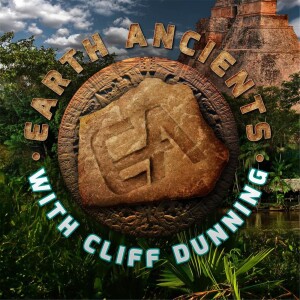
Dr. Richard Hansen: Uncovering the Maya Superhighways
 2023-04-15
2023-04-15
Download
Right click and do "save link as"
LiDAR analyses in the contiguous Mirador-Calakmul Karst Basin, Guatemala: an introduction to new perspectives on regional early Maya socioeconomic and political organization
LiDAR coverage of a large contiguous area within the Mirador-Calakmul Karst Basin (MCKB) of northern Guatemala has identified a concentration of Preclassic Maya sites (ca. 1000 B.C.–A.D. 150) connected by causeways, forming a web of implied social, political, and economic interactions. This article is an introduction to one of the largest, contiguous, regional LiDAR studies published to date in the Maya Lowlands. More than 775 ancient Maya settlements are identified within the MCKB, and 189 more in the surrounding karstic ridge, which we condensed into 417 ancient cities, towns, and villages of at least six preliminary tiers based on the surface area, volumetrics, and architectural configurations. Many tiered sites date to the Middle and Late Preclassic periods, as determined by archaeological testing, and volumetrics of contemporaneously constructed and/or occupied architecture with similar morphological characteristics. Monumental architecture, consistent architectural formats, specific site boundaries, water management/collection facilities, and 177 km of elevated Preclassic causeways suggest labor investments that defy the organizational capabilities of lesser polities and potentially portray the strategies of governance in the Preclassic period. Settlement distributions, architectural continuities, chronological contemporaneity, and volumetric considerations of sites provide evidence for early centralized administrative and socio-economic strategies within a defined geographical region.
Dr. Richard D. Hansen is a specialist on the early Maya and is the Director of the Mirador Basin Project in northern Guatemala. He has been conducting archaeological research and scientific studies in northern Guatemala for 38 years. He is an Affiliate Research Professor at Idaho State University, after serving as an Adjunct Professor of Anthropology at the University of Utah from 2014 to 2021. He was formerly a Research Professor in the Department of Anthropology at Idaho State University for 8 years and was Senior Scientist at the Institute for Mesoamerican Research at ISU. Prior to that, he was Assistant Research Scientist (Level IV) at the UCLA Institute of Geophysics and Planetary Physics for 12 years. He is the founder and president of the Foundation for Anthropological Research and Environmental Studies (FARES), a non-profit scientific research institution based in Idaho.
https://www.fares-foundation.org/
view more
LiDAR coverage of a large contiguous area within the Mirador-Calakmul Karst Basin (MCKB) of northern Guatemala has identified a concentration of Preclassic Maya sites (ca. 1000 B.C.–A.D. 150) connected by causeways, forming a web of implied social, political, and economic interactions. This article is an introduction to one of the largest, contiguous, regional LiDAR studies published to date in the Maya Lowlands. More than 775 ancient Maya settlements are identified within the MCKB, and 189 more in the surrounding karstic ridge, which we condensed into 417 ancient cities, towns, and villages of at least six preliminary tiers based on the surface area, volumetrics, and architectural configurations. Many tiered sites date to the Middle and Late Preclassic periods, as determined by archaeological testing, and volumetrics of contemporaneously constructed and/or occupied architecture with similar morphological characteristics. Monumental architecture, consistent architectural formats, specific site boundaries, water management/collection facilities, and 177 km of elevated Preclassic causeways suggest labor investments that defy the organizational capabilities of lesser polities and potentially portray the strategies of governance in the Preclassic period. Settlement distributions, architectural continuities, chronological contemporaneity, and volumetric considerations of sites provide evidence for early centralized administrative and socio-economic strategies within a defined geographical region.
Dr. Richard D. Hansen is a specialist on the early Maya and is the Director of the Mirador Basin Project in northern Guatemala. He has been conducting archaeological research and scientific studies in northern Guatemala for 38 years. He is an Affiliate Research Professor at Idaho State University, after serving as an Adjunct Professor of Anthropology at the University of Utah from 2014 to 2021. He was formerly a Research Professor in the Department of Anthropology at Idaho State University for 8 years and was Senior Scientist at the Institute for Mesoamerican Research at ISU. Prior to that, he was Assistant Research Scientist (Level IV) at the UCLA Institute of Geophysics and Planetary Physics for 12 years. He is the founder and president of the Foundation for Anthropological Research and Environmental Studies (FARES), a non-profit scientific research institution based in Idaho.
https://www.fares-foundation.org/
More Episodes
John Michael Greer: The Secret of the Temple
 2023-11-25
2023-11-25
 2023-11-25
2023-11-25
Anthony Woods: Atlantis Ireland
 2023-11-18
2023-11-18
 2023-11-18
2023-11-18
Destiny: Anne-Marie Keppel, Death Nesting
 2023-11-15
2023-11-15
 2023-11-15
2023-11-15
James Wood: The Great Pyramids of China
 2023-11-04
2023-11-04
 2023-11-04
2023-11-04
Destiny: Rob Fullington, An Alien Experience
 2023-11-01
2023-11-01
 2023-11-01
2023-11-01
Destiny: Chris Bledsoe, UFO of God
 2023-10-25
2023-10-25
 2023-10-25
2023-10-25
Joseph Selbie: The Physics of God
 2023-10-21
2023-10-21
 2023-10-21
2023-10-21
Walter Cruttenden: Ancient Cosmology
 2023-10-07
2023-10-07
 2023-10-07
2023-10-07
012345678910111213141516171819
Create your
podcast in
minutes
- Full-featured podcast site
- Unlimited storage and bandwidth
- Comprehensive podcast stats
- Distribute to Apple Podcasts, Spotify, and more
- Make money with your podcast
It is Free
- Privacy Policy
- Cookie Policy
- Terms of Use
- Consent Preferences
- Copyright © 2015-2024 Podbean.com


